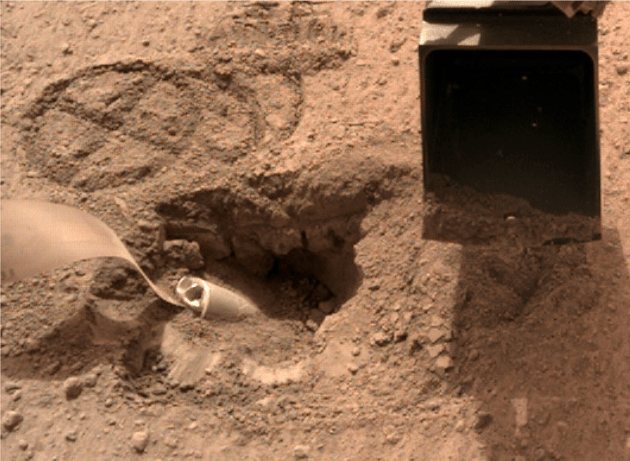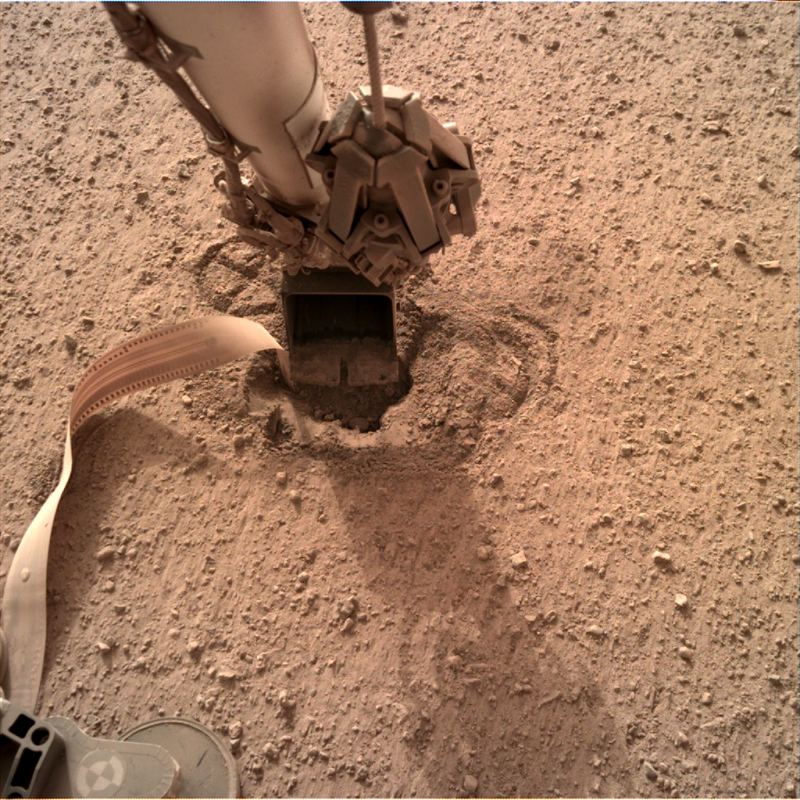The InSight lander is making progress on Mars. After many months of struggle and careful adaptation, the InSight lander’s ‘Mole’ is finally into the ground. There’s still more delicate work to be done, and they’re not at operating depth yet. But after such a long, arduous affair, this feels like a victory.
The InSight (Interior Exploration using Seismic Investigations, Geodesy and Heat Transport) lander was sent to Mars to study the planet’s interior. Though it’s largely a NASA mission, the German Aerospace Center (DLR) built one of the lander’s key instruments, the Heat Flow and Physical Properties Package (HP3), affectionately called the Mole. The Mole’s job is to measure the heat flowing from Mars’ interior to the surface.
But to do that, it has to hammer its way down below the surface. Ideally, it would penetrate to a depth of about five meters, although it can still get good data at a depth of about three meters. The problem is, the Martian surface hasn’t been cooperating, and the Mole has barely been able to make any progress penetrating below the surface.
But according to Tilman Spohn, the Mole’s Principal Investigator, recent attempts to get the probe into the ground are paying off.
The obstacle facing the Mole is what’s called duricrust. It’s a compacted, hardened layer of dirt underneath a thin layer of sand. Due to the design of the Mole, that duricrust has created a big problem.
The Mole self-hammers its way below the surface. For that to work, it relies on friction with the sides of its hole to counteract the Mole’s recoil action. The idea was that as the Mole hammered, the material surrounding the Mole would fill in as it hammered, providing the friction.

But the duricrust has prevented that from happening. It’s so compacted that it won’t flow freely into the Mole’s hole, and won’t provide the necessary frction. And the loose sand from the thin surface layer seemed to simply disappear into the hole during the hammering action. Over the months, the team has tried several methods of getting the Mole into the ground.
They’ve tried using the scoop on the instrument arm to help the Mole penetrate. They pushed on the side of the Mole to try to provide the necessary friction, but that didn’t work. They tried, carefully, to push down on the Mole without damaging the wiring harness. That didn’t work either.
They also tried using the scoop to push loose surface sand into the hole, hoping that would provide the necessary friction. While all of these methods helped a little, they weren’t solutions.
In fact, some of those attempts may have exacerbated the problem.
As the team has tried all these things, the Mole has been hammering the same soil. The concern now is that the soil directly under the instrument has become compacted, which is another obstacle to the Mole’s success.
In early June, NASA and the DLR announced that the Mole had made it underground.
In July, they announced that although the Mole was now underground, it might still be stuck. That’s because once the Mole is no longer protruding from the ground, the scoop on the instrument arm can’t help anymore. The Mole is on its own.
Now the DLR has released some new images of the Mole, and Principal Investigator Tilman Spohn has written a new blog post updating us on the Mole’s situation. The team has moved the scoop out of the way in order to allow the cameras to examine the soil and the situation more closely.
“Following the Free Mole Test conducted in June (see logbook entry from 7 July 2020), the ‘Mole’ team decided to lift InSight’s arm and scoop and take a look at the Mole in the pit,” Spohn wrote in his blog. “Some of us had expected – or feared – that the previous hammering actions would have drained the sand from the pit. The sand, so the thinking went, would have loosened and fallen into possible deeper cracks and cavities in the duricrust. After all, we are still puzzled about where all the material – about 300 cubic centimetres or 10 ounces – went when the pit formed back in March 2019.”

According to Spohn, the team was pleased to see the state of things in the new images. It’s mostly covered in sand now, with only a tiny portion of the instrument visible on the surface. There’s more sand in the pit now, which they think may be duricrust pulverized by all the hammering.
But they had to figure out what to do next, and a lively debate broke out.
“Some were in favour of filling the pit, compacting the sand in the pit, and then pushing the scoop onto the surface to provide force, which would then be transmitted to the Mole by the sand,” wrote Spohn. The sand and the downward force would conteract the instrument’s recoil, they hoped.
But others had a different idea. “Others argued that we should first try to get the Mole a few centimetres deeper by pushing the back cap with the tip of the scoop.”
After much discussion, they decided to push down on the Mole with the scoop. They’d done that before and had success, so, they reasoned, maybe it’ll work again.
But that’s a risky move. There’s a risk of damaging the wiring harness, which could be disastrous for the mission. And the scoop would need to be re-oriented to contact the Mole, another risk.

“After intense discussion, the team decided to first do a push on the back cap, similar to the successful back cap pushes conducted in the past months. The only problem is that in the previous configuration – bottom down – the scoop no longer fits in the pit,” Spohn wrote.
“You can lift the scoop and push with the blade, but this means a higher risk of slipping and either damaging the cable or not being able to prevent the Mole from ‘hammering backwards’. I have already mentioned that the placement of the scoop is risky and must be done with millimetre accuracy,” wrote Spohn. “With the blade down, this is even more difficult than before.”

The team decided to do what they’re calling a ‘scrape test.’ The idea is to use the scoop to scrape more loose surface sand into the hole. They had no idea how successful that would be, but doing the test would “give us more time to see how the scoop might fit into the pit using CAD models,” Spohn wrote.
Spohn says the the scraping was a complete success, and much more effective than they thought it would be. “The scrape was much more effective than expected and the sand filled the pit almost completely. The Mole is now covered, but there is only a thin layer of sand on the back cap,” Spohn wrote in his blog.

So now the Mole is in the position they were hoping it would be in months ago: buried.
But the saga isn’t over yet. The team still intends to use the scoop to apply downward pressure on the Mole inside its hole. “This is first of all a somewhat simpler, more predictable and less time-consuming operation compared to a sequence of scraping movements; possibly combined with movements of the shovel to fill the pit,” Spohn wrote.
“I think, at the latest after filling the pit, we should be able to counter the recoil with sufficient force and the Mole will hopefully ‘dig’ deeper into the Martian soil on its own. Keep your fingers crossed!”
If this works, it will cap an impressive feat of interplanetary troubleshooting. And we may already have an indication of what the Mole can tell us when it gets to its operating depth.
“As a supporting indication, I note that a recent measurement of the thermal conductance from the Mole to the regolith shows increased values over earlier measurements. This suggests that both the thermal and mechanical contact have improved. So we’re feeling optimistic!”

